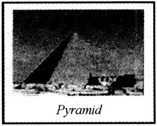
下载APP

【简答题】


阅读理解。

The oldest stone buildings in the world are the pyramids. They have stood for nearly 5000 years, and it
seems likely that they will continue to stand for thousands of years yet. The most famous of these are the
'Step' pyramid and the 'Bent' pyramid.
Some of the pyramids still look much as they must have done when they were built thousands of years
ago. Most of the damage (破坏) has been at the hands of men who were looking for treasure or, more often,
for stones to use in modern buildings. The dry climate of Egypt has helped to preserve the pyramids, and their
very shape has made them less likely to fall into ruin (废墟). These are good reasons why they can still be
seen today, but perhaps the most important is that they were planned to last forever.
It is most likely that plans were made for the building of the pyramids because the plans of other large
works have fortunately been preserved. But, there are no writings or pictures to show us how the Egyptians
planned or built the pyramid themselves. As a result, we are only able to guess at the methods used.
However, one thing is certain: there must have been months of careful planning before they could begin to
build. The first thing they had to do was to choose a suitable place. You may think this would have been easy
with miles and miles of empty desert around, but a pyramid could not be built just anywhere. Certain rules
had to be followed, and certain problems had to be overcome.
The pyramid had to be on the west side of the Nile, the side on which the sun sets. This was for religious
reasons. The pyramid also had to stand well above tho level of the river to protect it against the regular floods.
The pyramid could not be too far from the Nile, however, as the stones to build it needed to be carried in boats
down the river to the nearest point. Water transport was, of course, much easier than land transport. The
builders also had to find a rock base which was not likely to crack under the great weight of the pyramid.
Finally, the pyramid had to be near the capital, or better still, near the king's palace so that he could visit it
easily and personally check the progress being made on the final resting place for his body.
1. Most of the damage to the pyramids has been caused by _______.
A. stones
B. rivers
C. weather
D. men
2. What's the meaning of the underlined word preserve?
A. Damage.
B. Protect.
C. Build.
D. Cover.
3. What was the first thing people had to do before they could begin to build?
A. To follow the rules.
B. To draw the pictures.
C. To choose the right place.
D. To find the workers.
4. To protect a pyramid from floods they could have built it a long way from the Nile, but _______.
A. it had to be built on the west side of the river Nile where the sun sets
B. it was difficult to find a large enough rock base so far from the fiver
C. this would have been impossible because of religious reasons
D. this would have made it very difficult to transport the materials
题目标签:废墟
举报
参考答案:


参考解析:




刷刷题刷刷变学霸
举一反三

【单选题】地震时被废墟埋压怎么办?( )
A.
挪开脸前、胸前的杂物,消除口、鼻的灰尘。
B.
尽力挣脱手脚,小心翼翼地清除压在身上的物体。
C.
用可移动的物品支撑身体上面的重物,以免倒塌。
D.
用毛巾、手帕等捂住口鼻,尽量朝有光亮或宽敞的地方移动。
E.
当听到外面有声响时应进行呼救。
F.
若无法脱险,应保存体力,等待救援。
G.
以上都对。
【单选题】When we got to Yushu airport , we were told that they________more than 500 people from the ruins(废墟) by earthquake.
A.
has saved
B.
saved
C.
had saved
D.
have saved

